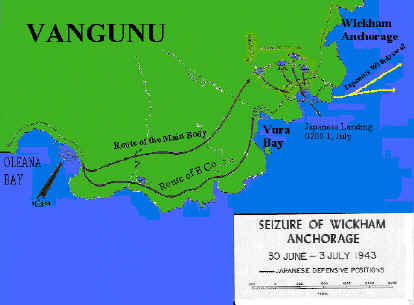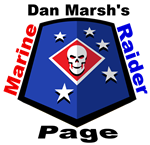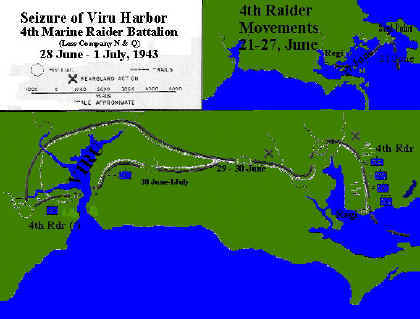The Third Raider Battalion was activated 20 Sept. 1942 on the island of Samoa. It was the only Raider Battalion formed overseas and was under the able command of Lt. Col .Harry B. Liversedge This fine unit consisted of volunteers from Marine units on the island plus a cadre of 27 officers and men from both the 1st and 2nd Raiders. To provide for the proper training the battalion moved in January,1943 to Espirtu Santo. Then in the middle of February they moved up to Guadalcanal to prepare for the invasion of the Russell Islands.
Their objective was the island of Pavuvu while a U.S. Army unit would assault the island of Banika. The 3rd Raiders moved up the slot on APD’s during the night of 20 February subsequently making an unopposed landing in rubber boats early morning 21 Feb. It was soon apparent the Japanese had evacuated the island leaving a horde of rats behind. After securing the island they settled down to a month of garrison duty. Finally on 20 Mar. the 3rd Raiders were withdrawn to a base camp in Noumea, New Caledonia by way of Espirtu Santo. On 12, Sept. the 2nd and 3rd Raiders were re-designated the 2nd and 3rd Battalions, 2nd Marine Raider Regiment (provisional) 1MAC. under the command of Lt. Col. Alan Shapley. Both units began intensive training in preparation for the assault on Bougainville.
UP THE SLOT-NEW GEORGIA
Following the Makin raid, Major James Roosevelt, Executive Officer of the 2nd Raiders returned to the states to command the 4th Raider Battalion. This unit was activated 23, Oct. at Camp Pendleton and immediately began Raider training at a remote location known to the Raiders as tent camp 3. On 8 Feb. 1943, their training completed, they boarded the US President Polk for transport to Espirtu Santo, New Hebrides Islands. On arrival the 4th Raiders established their base camp and continued extensive training with emphasis on night operations. On 22, March their designation was changed to 4th Raider Battalion, 1st Marine Raider Regiment and their company designations were changed accordingly. Also in May Lt. Col. Michael S Currin assumed command of the battalion when Lt. Col. Roosevelt returned to states for medical reasons. The 4th Raiders moved to an advanced base at Tetere, Guadalcanal 2 June 1943 to prepare for combat operations on New Georgia.
In late June the counter offensive against the Japanese, continued to move up the slot. The 4th Raiders were assigned two concurrent missions that would require dividing the command. Lt. Col. Currin assumed responsibility for the move against Viru Harbor utilizing O, P and part of Hq. Companies, while the Executive Officer Major James R.Clark would command N, Q and the rest of Hq. Companies for the invasion of Vangunu Island.
Currin’s Raiders boarded APD’s at Tetere 20 June for the move north. In the early morning hours of 21 June they went ashore at Segi Pt. And quickly organized a defensive perimeter.
Embarking in rubber boats early evening 27 June, Currin’s Raiders moved west along the coast to Regi village. By 2:00 A.M. 28 June, they were safely ashore. a perimeter established and return of their boats to Segi in progress. At dawn, the Raiders began their advance on Viru Harbor through jungle terrain that defies description. Delayed and hampered by slimy thick mud, mangrove swamps and entangling jungle growth they pressed continually forward. Despite all these obstacles and sudden fire fights in which casualties were incurred, they enveloped and captured Viru Harbor on 1 July.The Raiders movement from Segi to Viru Harbor remains as a classic example of the hazards of jungle warfare. On 10 July Currin’s men boarded LCI’s at Viru and returned to their base at Tetere to await further orders.
Major Clark’s Raiders boarded APD’s at Tetere 28 June, and entered Oleana Bay, Wickham Anchorage early morning 30 June. Landing operations began in darkness as scheduled but soon were disrupted by heavy rain, strong winds and high surf. As a result some units were put ashore 6 miles from the designated beaches. However, there was no panic and scattered units quickly got their bearings, moved inland and made their way toward the beachhead. Major Clark moved out from the beach with less than 100 men confident that the scattered units would soon join him. The Coastwatcher Trail they followed was a sea of mud and jungle growth hampered their movement as well as two rivers running deep and strong. Regardless, by 1:30 they were in position to attack the Japanese positions in Kaeruka village. Fortunately the delays had allowed all the scattered units to rejoin the main body and participate in the assault.
NOTE: The Vangunu operations were under the overall command of Lt. Col. Lester E. Brown USA. Major Clark of the Raiders was subject to his orders and operational plans. This brief review is concerned only with the activities of the Marine Raiders.

The coordinated attack by the Raiders and Army troops was launched around 2:00 P.M. Resistance was light initially but became very heavy as the attack developed. Under steady pressure the Japanese defenders became confused and in late afternoon the two Raider companies were able to push through to the beach. The Army units also broke through to complete the victory. Major Clark quickly had the Raiders consolidate their positions and establish a strong perimeter facing both the Kaeruka river and the beach. This proved to be a wise decision. The early evening was uneventful but in the early morning the Japanese made an abortive attempt to land from three barges. They probably thought they were in the rear of our defenses. The Raiders and the USA troops were alert and quickly destroyed the landing force.
Clark’s Raiders were detached from Lt . Col. Brown’s command on 4 July, and returned by LCI transport to Oleana Bay to rest and reorganize. A few days later they were transported to Gatukai Island to search for Japanese troops reported to be there by natives. Combat patrols found evidence of their recent presence but apparently had been evacuated. Clark’s Raiders returned to Oleana on the 12th of July, and then by LCI transport to their base at Tetere, Guadalcanal.

